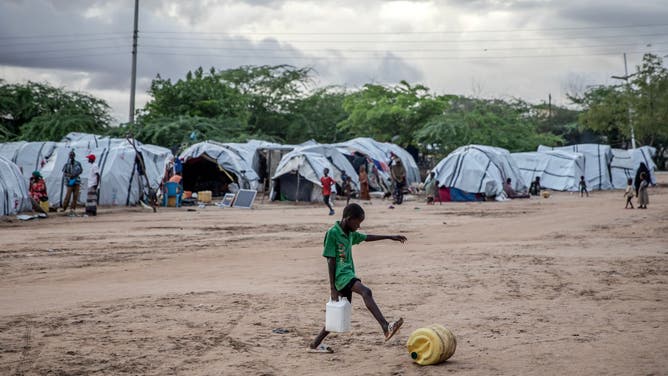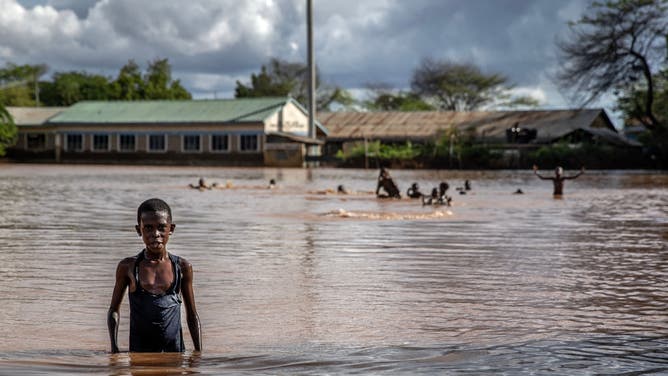Death toll continues to rise in Africa after flooding cripples communities
"This is not over and it’s not yet at its peak. It’s getting worse and these people are going to suffer more," said head of Somalia's ICRC about the forecast for El Nino bringing heavy rains into spring.
Deadly flooding in Somalia already killed 96
Deadly flooding triggered by El Nino fueled heavy rain storms has so far killed at least 96 in Somalia. Displaced villagers wade through floodwater in their temporary settlement. Reuters talks to villagers and the head of the International Committee of the Red Cross for Somalia, Pascal Cuttat.
More than 250 people are dead in the Horn of Africa as El Nino-fueled storms continue to pound villages, and flash flooding sweeps them away.
"We are dealing with a situation where entire communities have either been submerged or marooned. Roads and other critical infrastructure have been cut off, disrupting the delivery of vital supplies," said Ahmed Idris, Secretary General of the Kenya Red Cross Society in a statement. "We need to urgently provide food, clean water and medical supplies to avoid a humanitarian catastrophe."
Reuters reports 120 deaths so far due to the flooding, while almost 90,000 families were forced to leave their homes in Kenya alone. Aid agencies state that thousands of homes were washed away and tens of thousands of livestock drowned. Early U.N. figures point to 240 acres of farmland destroyed as well. In Ethiopia, flooding killed 44, according to the A.P.
HERE’S WHAT AN EL NINO CLIMATE PATTERN IS

People carry their belongings while crossing the section of a road collapsing due to flash floods in Kenya on November 22, 2023.
(LUIS TATO/AFP / Getty Images)
Somalia tragedy
In Somalia, 96 people were killed during the flooding, according to the Commissioner of the Somali Disaster Management Agency. In a tragic turn of events, 28 of those victims were on a rescue boat that capsized due to terrorist interference, he said.
As villages are submerged, the Red Cross reports that crews are rescuing people out of trees.
"The floods swept everything, including our mattresses. We slept on a mattress. We ran for our lives and are currently in a Madrassa building at night," a displaced woman in Somalia told Reuters. "We are really in a hard situation. May God help us."
The water forced about 700,000 from their homes, an official told Reuters. Video shows the evacuated wading through water, even at their emergency settlements. Many don't even feel safe at the emergency shelters.
"These floods are double compared to the previous ones. You can't take a risk in this one. When it is raining, we sit outside under a tent until the rain slows down," a displaced mother told Reuters. "We only come in the house when the rain slows down so that we can cook for the children."
STRONG EL NINO WINTER: WHAT KIND OF WEATHER YOU CAN EXPECT

A boy carries water at an internally displaced persons (IDP) camp for families displaced by floods in Kenya,
(LUIS TATO/AFP / Getty Images)
Blame El Nino: ‘It’s not at its peak. It's getting worse, and people will suffer more'
Officials blame two atmospheric phenomena: El Niño and the Indian Ocean Dipole.
"The Indian Ocean Dipole has two phases much like ENSO (El Nino Southern Occilation), a positive phase when sea-surface temperatures are above average in the Indian Ocean and a negative phase when sea-surface temperatures are below average in the Indian Ocean," explained FOX Weather Senior Weather Data Specialist, Shane Brown. "El Niño and the positive phase of the Indian Ocean Dipole tend to run in tandem, and that is indeed what we are seeing now."
Both the positive IOD and El Niño generally mean increased rainfall for the season. Together, they are overwhelming the Horn. And the pattern looks to be sticking around.
EL NINO'S ODDS FOR ‘HISTORICALLY STRONG’ EVENT INCREASE; COULD LINGER THROUGH SPRING

A herder assists some of his goats to cross a flooded area next to a road destroyed by flash floods in Kenya.
(LUIS TATO/AFP / Getty Images)
"Overall, we have now roughly over 650,000 people displaced and 1.4 or 1.5 million people - to be very honest, nobody really knows the concrete figures - are going to be affected. That is now but, we have currently a confluence still of the Indian Ocean dipole of El Nino, we have a cyclone building up in the Indian Ocean, we have rains continuing in the highlands of Ethiopia," said Pascal Cuttat, head of the International Red Cross Committee to Reuters. "All of that means that this is not over, and it’s not yet at its peak. It’s getting worse, and these people are going to suffer more."
NOAA analysts forecast at least a strong El Nino to linger into spring, with a chance that it will become a super El Nino. The rains started in October.
Flood after drought
These rains come after a deadly drought, "worst in decades," officials said, which destroyed crops, killed cattle and forced people to leave their homes. Somalia alone lost 43,000 people to drought in 2022, according to Reuters. The U.N. called it the worst drought in 40 years.
One resident said he prefers famine over feast.
"During the drought, we were able to walk to get food, now there is nowhere to walk," a man in Kenya told Reuters. "The floods are here, but we cannot drink this water or (eat the) fish from it."

A child looks on as others play and swim at an inundated football Feild in Kenya.
(LUIS TATO/AFP / Getty Images)
As weeks of flooding turn into months, disease is a concern.
"We are also looking at a situation whereby disease outbreaks related to water-borne and vector-borne diseases are beginning to emerge because, besides the primary care for those people with chronic illnesses who normally need to access health facilities, another effect we are likely to see is contamination of water," the Disaster Risk Manager of the Kenya Red Cross Society told Reuters. "Because with the surface runoff water and with increased water levels, contamination is likely to happen in cases where latrines have been swept off and as a result, you are finding that the water has been contaminated and when they take that then it leads to disease outbreaks."
The worst previous El Niño event brought flooding in 1997/1998. The Kenya Red Cross stated that the area suffered "widespread and massive destruction of infrastructure that took the country decades to recover."
